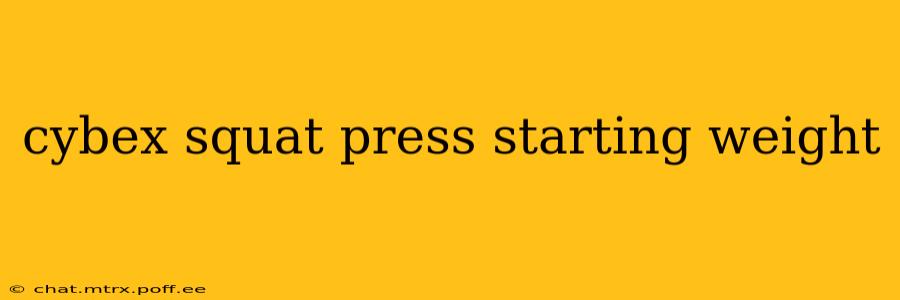The Cybex Squat Press is a powerful machine for lower body strength training, offering a safe and effective way to build leg and glute strength. However, determining the right starting weight is crucial to avoid injury and maximize results. There's no one-size-fits-all answer, as the ideal starting weight depends on several factors. This guide will help you find the perfect weight to begin your Cybex Squat Press journey.
What Factors Determine My Starting Weight on the Cybex Squat Press?
Several factors influence your starting weight on the Cybex Squat Press:
-
Your Strength Level: Are you a complete beginner, someone returning to exercise, or someone already familiar with strength training? Your experience significantly impacts your starting weight. Beginners should start much lighter than experienced lifters.
-
Your Body Weight: Heavier individuals generally start with heavier weights than lighter individuals, as they possess more overall mass to move.
-
Your Training Goals: Are you focused on muscular endurance, hypertrophy (muscle growth), or strength? Your goals will influence the weight and rep ranges you choose.
-
Proper Form: Maintaining proper form is paramount. Starting with a weight that allows you to maintain correct form throughout the entire range of motion is critical for safety and effectiveness. Sacrificing form to lift heavier weight increases the risk of injury.
How Much Weight Should I Start With on the Cybex Squat Press?
For beginners or those returning to exercise, it's recommended to start with the empty bar or the lowest weight setting on the machine. Focus on mastering the proper form before increasing the weight. Perform 8-12 repetitions with good form for 2-3 sets. If you can easily complete all sets and reps with good form, then it's time to increase the weight slightly.
What If I'm an Experienced Lifter?
Experienced lifters should perform a few warm-up sets with lighter weights before progressing to their working weight. Even experienced individuals should prioritize good form over lifting heavy weight. A good starting point might be to use a weight that allows you to perform 6-8 repetitions, maintaining impeccable form for 3 sets. Then, progress from there. Always listen to your body.
How Much Weight Should I Add Each Workout?
Gradually increase the weight incrementally. A good rule of thumb is to add 2.5-5 lbs (or 1-2.5 kg) per side to each set, depending on the machine’s weight plate increments. However, don’t be afraid to adjust based on your progress and how your body responds.
What Are Some Common Mistakes to Avoid?
- Ignoring Proper Form: This is the most crucial mistake to avoid. Prioritize proper form over lifting heavy weight. Compromising form increases the risk of injury.
- Increasing Weight Too Quickly: Gradually increase the weight. Rapid increases can lead to plateaus and injuries.
- Not Warming Up: Always warm up your muscles before starting your workout. A proper warm-up prepares your body for the exercise and reduces the risk of injury.
- Ignoring Your Body: Listen to your body. If you experience pain, stop immediately and rest.
What Exercises Can I Do to Prepare for the Cybex Squat Press?
Bodyweight squats, goblet squats, and lunges are excellent exercises to prepare your muscles for the Cybex Squat Press. These exercises will build foundational strength and help you to develop proper form.
Can I Use the Cybex Squat Press for Different Training Goals?
Yes! The Cybex Squat Press is versatile and can be adapted for different training goals:
- Strength: Focus on lower repetitions (1-5 reps) with heavier weight.
- Hypertrophy (muscle growth): Aim for moderate repetitions (8-12 reps) with a weight that allows for controlled movements.
- Endurance: Use higher repetitions (15-20 reps) with a lighter weight.
Remember to consult with a certified personal trainer or healthcare professional before starting any new exercise program. They can assess your fitness level and help you develop a safe and effective workout plan tailored to your needs and goals. The information provided here is for general guidance only and doesn't substitute professional advice.
